Layman D. Biology Demystified: A Self-Teaching Guide
Подождите немного. Документ загружается.

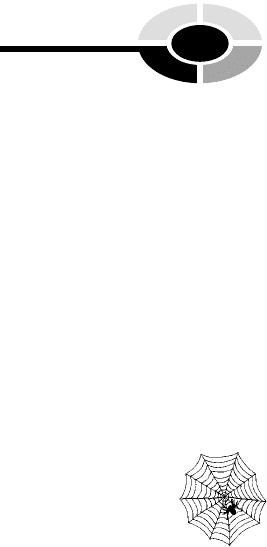
ACOELOMATES: NO MAIN BODY CAVITY
The previous section told us that in all animals except sponges, there is an
archenteron present in the embryo. This archenteron is a hollow tube essen-
tially representing the beginning structure of the digestive tract. All animals
must have such a digestive tract, because they are heterotrophs consuming
food which provides them with needed energy. Since metabolism is never
100% efficient, some of the ingested food matter is excreted through the
anus (AY-nus) as feces.
A further way of classifying the bilateral invertebrates can now be con-
sidered. It is the answer to the following question: ‘‘Does the animal’s body
contain a coelom (SEE-loam) – central body ‘‘cavity’’ – around its archenter-
eon (digestive tract), or not?’’
The additional way of classifying animals thus becomes one of distinguish-
ing the coelomates (SEE-luh-mates) from the acoelomates (ay-SEE-luh-
mates). The coelomates, quite obviously, are those bilateral invertebrates
whose bodies contain a coelom (central cavity), whereas the acoelomates
have no central body cavity.
The distinction becomes clear when one examines Figure 10.4. The acoe-
lomates are generally considered the more primitive or most ancient organ-
isms (according to the Fossil Record). Representative of the acoelomates are
the planaria (plah-NAIR-ee-uh). The planaria are free-swimming flatworms
that have a solid body (containing no coelom around their digestive tube).
The planaria are carnivores. They catch and eat smaller animals, and feed on
dead organisms in the water. The planaria have amazing powers of regenera-
tion. This means that they are able to re-grow large portions of their bodies
when they are cut off and removed. This trait has made them a valuable
research tool for biologists seeking to learn how to promote regeneration
of lost or damaged human body parts. [Study suggestion: Compare the
name planaria with similar words like plantar and plaintain (Chapter 10).
From a look at Figure 10.4 (A), after what specific characteristic is the
planaria worm named?]
Midway between the acoelomates and the coelomates is a very large group
of invertebrates called the pseudocoelomates (SOO-doh-see-luh-mates). This
group is so large because it contains over 90,000 known species of nematodes
(NEM-ah-toads). Nematodes are slender, ‘‘thread’’ (nemat)-‘‘shaped’’ (-ode)
worms. The nematodes (threadworms) are alternately called the roundworms.
But their bodies tend to be narrow and cylinder-shaped, and they are often
tapered at either end (Figure 10.4, B).
The nematodes (roundworms, threadworms) are classified as pseudocoe-
lomates because their bodies contain a ‘‘false’’ (pseudo-) ‘‘cavity’’ (coelom).
CHAPTER 10 Invertebrates 167
[13:25 13/6/03 N:/4058 LAYMAN.751/4058-Alltext.3d] Ref: 4058 Layman: Biology Demystified All-text Page: 167 1-388
4, Web
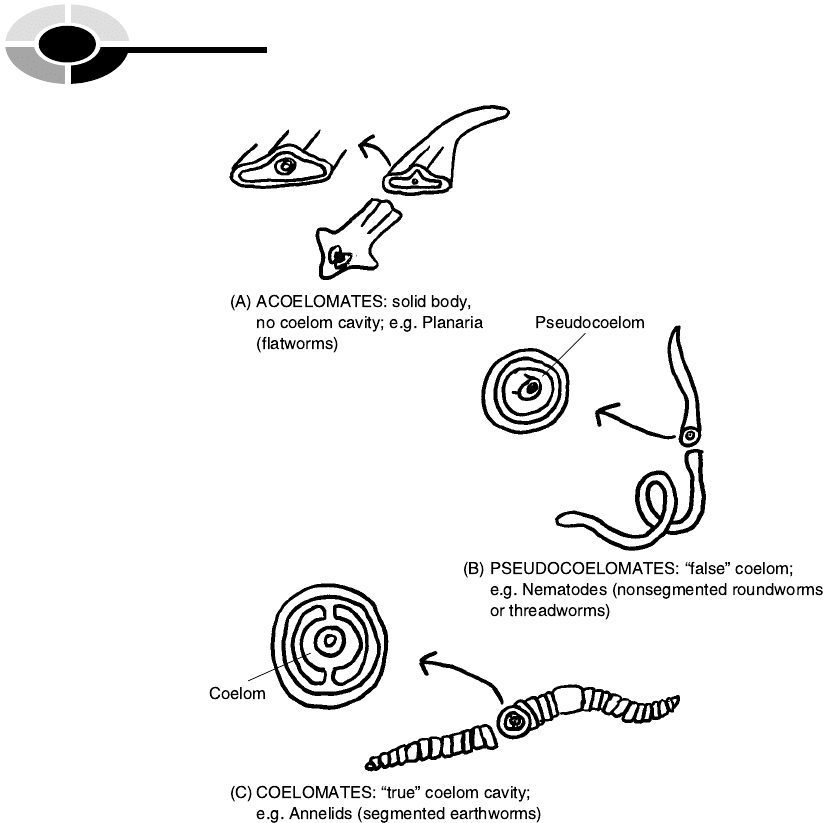
These slender worms have a complete digestive tube, which extends from the
mouth all the way to the anus. Their muscles run lengthwise through their
entire bodies, which are nonsegmented (not divided into small segments). But
there is no ‘‘true’’ coelom (cavity with an actual lining of mesoderm) between
the muscles and the digestive tube. There is, instead, a pseudocoelom cavity
that is filled with fluid, but is not lined with mesoderm.
Finally, we turn to the coelomates. The coelomates are commonly repre-
sented by the annelids (AN-eh-lids) – the worms with many ‘‘little rings’’ of
muscles encircling their bodies. The most familiar annelid is the common
earthworm (Figure 10.4, C). The earthworm is considered a segmented
worm, due to the division of its body into numerous ring-like segments.
The fluid-filled space surrounding its digestive tract is a true coelom, because
[13:25 13/6/03 N:/4058 LAYMAN.751/4058-Alltext.3d] Ref: 4058 Layman: Biology Demystified All-text Page: 168 1-388
PART 3 Five Kingdoms of Life, plus Viruses
168
Fig. 10.4 No body cavity, ‘‘false’’ body cavity, or ‘‘true’’ body cavity?

it is lined by cells from the mesoderm. Earthworms are probably the most
frequently studied of all coelomates in introductory biology classes. But
human beings, like earthworms, are also coelomates! In both annelids
(such as earthworms) and humans, the fluid within the coelom acts as a
valuable shock absorber, cushioning the internal organs from blows hitting
the outer body surface. It also moistens and lubricates them, reducing their
friction and rubbing during body movements.
The Mollusks: ‘‘Clam Up, Would ya’?’’
Closely related to the segmented worms is another group of coelomates, the
mollusks (MAHL-usks). This phylum of mollusks consists of a huge number
of more than 100,000 different species of invertebrates with ‘‘soft bodies’’
(mollusc) that are nonsegmented. Mollusks include clams, snails, oysters,
squids, and octopuses. ‘‘What could such more-or-less round-shaped organ-
isms without segments possibly have in common with the segmented annelid
worms?’’ you might well ask. The answer is that both annelids and mollusks
probably have a common ancestor in the Fossil Record, and they were the
first two groups of animals to develop a true fluid-filled coelom cavity, lined
with mesoderm cells.
BASIC BODY PLAN OF THE MOLLUSKS
Because they have a soft body, many kinds of mollusks are protected by a
rock-hard, calcium-rich shell. Those early mollusks who developed this adap-
tation would obviously have enjoyed a much greater protection from hungry
predators. Squids and octopuses have either a much-reduced shell, which is
mostly internal, or they have lost their shells entirely.
Despite their obvious differences in degree of protection by shells, the
mollusks all share a common basic body plan. The basic plan is shown in
Figure 10.5. The three main parts of any mollusk are the mantle, visceral
(VIH-sir-al) mass, and foot. The mantle is a ‘‘little cloak’’ or covering on the
back of the mollusk. The covering tissue within the mantle produces the hard
shell in many species. And since it is on the back or superior surface of the
mollusk, the mantle functions in respiration, exchanging gases with the sur-
rounding air or water. In hundreds of mollusk species, there is a mantle cavity
also present below the mantle itself. The mantle cavity contains, in turn, a set
of gills. Since the mantle is hardened by an additional shell, it has a reduced
CHAPTER 10 Invertebrates 169
[13:25 13/6/03 N:/4058 LAYMAN.751/4058-Alltext.3d] Ref: 4058 Layman: Biology Demystified All-text Page: 169 1-388
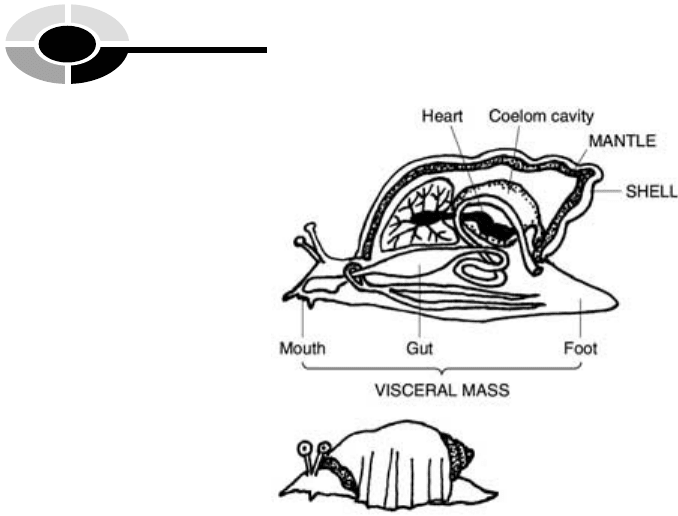
surface area available for diffusion of oxygen (O
2
) into the blood, and diffu-
sion of carbon dioxide (CO
2
) out. This reduced surface area available for
respiration is compensated for by the gills, which assist with this critical job.
The visceral mass is the main soft body of the mollusk, which contains the
major viscera (VIH-ser-ah) or ‘‘guts’’ (internal organs). The coelom cavity is
also found within the visceral mass. It holds the heart of the organism. The
foot of the mollusk is the inferior portion of the visceral mass, which, some-
what like a human foot, is large and fleshy and flat. The foot pushes against
the ground or sea bottom, propelling the mollusk forward.
In addition to their basic body plan, many species of mollusks are classi-
fied as bivalves (BUY-valves). This is because they have ‘‘two’’ (bi) shells
hinged tightly together, like a ‘‘valve.’’ This double-valve, when opened,
gives the organisms bilateral symmetry. Bivalves include such well-known
invertebrates as the clams, oysters, mussels, and scallops.
Echinoderms: ‘‘Such A Prickly Skin May Make
You A Star!’’
Bivalves have bilateral (mirror-image) symmetry, while adult starfish possess
radial symmetry. Various species of starfish, along with the sea urchins (UR-
chins), belong to a phylum of invertebrates called the Echinoderms (ih-KY-
[13:25 13/6/03 N:/4058 LAYMAN.751/4058-Alltext.3d] Ref: 4058 Layman: Biology Demystified All-text Page: 170 1-388
PART 3 Five Kingdoms of Life, plus Viruses
170
Fig. 10.5 Basic body plan of the mollusks.
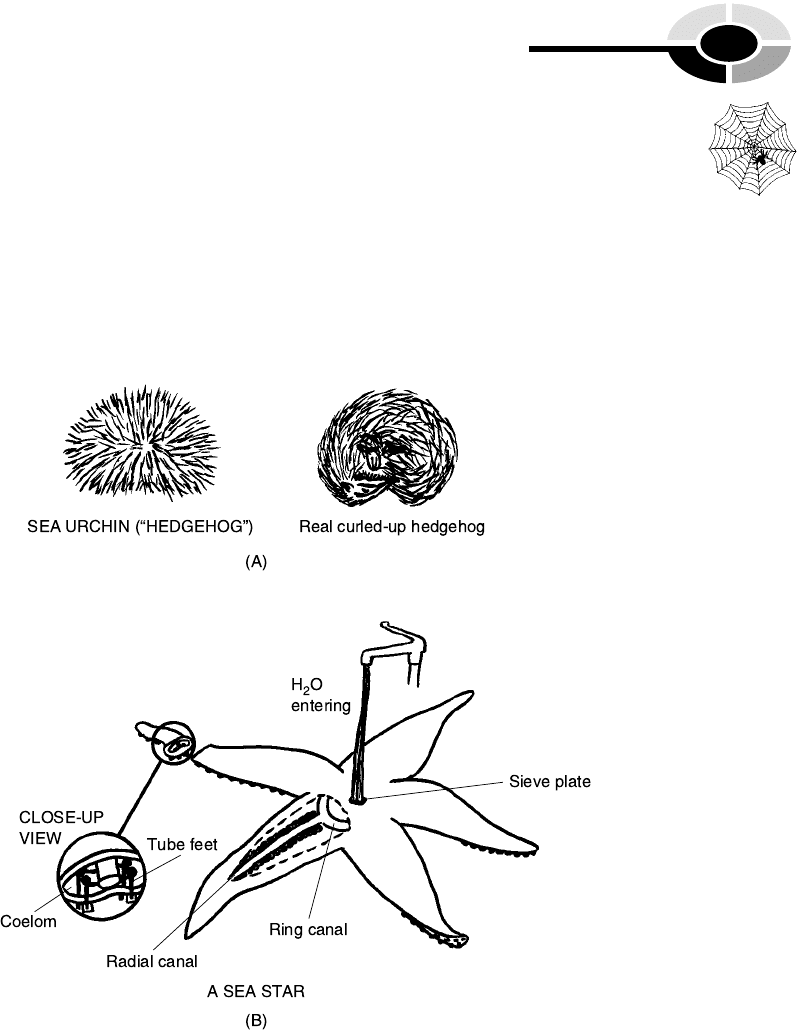
nuh-derms). The Echinoderms are a group of small sea animals covered by a
spiny ‘‘skin’’ (derm) that forms a hard protective shell. This phylum gets its
name from the numerous spines on the surface of the animals, which give
them the appearance of a sea-dwelling ‘‘hedgehog’’ (Echino-). The sea urch-
ins, in particular, look much like real ‘‘hedgehogs’’ (urchins)! The sea urchins
(Figure 10.6, A) are a group of small, round Echinoderms with hard shells
consisting of moveable, calcium-hardened spines. Like a hedgehog, the ani-
mal curls up and projects its sharp spines as a protective reaction when it is
being attacked by a hungry predator.
The starfish (not being fish), are more accurately called sea stars. Like the
sea urchins, the sea stars possess radial symmetry in their adult form.
Interestingly enough, however, all the Echinoderms grow into radially sym-
metrical adults from larvae (LAR-vee) or immature ‘‘ghosts’’ (larva) that are
CHAPTER 10 Invertebrates 171
[13:25 13/6/03 N:/4058 LAYMAN.751/4058-Alltext.3d] Ref: 4058 Layman: Biology Demystified All-text Page: 171 1-388
5, Web
Fig. 10.6 The prickly Echinoderms.

bilateral and free-swimming. The conversion of immature larvae with bilat-
eral symmetry into mature Echinoderm adults with radial symmetry appar-
ently reflects an adaptation to a more-or-less stationary and slow-moving
existence on the ocean floor.
The sea star consists of a central body, with five arms radiating out like
spokes from the hub of a wheel (Figure 10.6, B). Its inferior mouth opens into
a digestive tract. Besides its prickly skin, the sea star shows another feature
unique to the Echinoderms: a water vascular (VAS-kyoo-lar) system. This
vascular system is contained within the animal’s coelom (main body cavity).
A small sieve plate, present on the superior surface of the animal, filters
seawater (like a sieve with holes) just before it enters the sea star and flows
down a short tube. The tube connects to a central ring canal, and from there
into individual radial canals, which circulate the filtered water into each
prickly arm.
Besides acting as a circulatory system for nutrients and waste products,
the water vascular system serves as a hydrostatic (HIGH-druh-stat-ik)
skeleton. The ‘‘water’’ (hydro-) within the vascular canals provides a
‘‘steady’’ (static) pressure. This hydrostatic pressure allows the sea star to
use the suckers on its hundreds of tube feet to push down and slowly drag
its prickly body across the ocean floor. The water-driven pressure is even
great enough to allow the star to raise its arms and grasp prey, such as
sponges, mollusks, and oysters.
Invertebrates Respond to ‘‘Breaking
Symmetry’’ of Their Body Form
We have talked about the concept of Biological Order, as contrasted with
Biological Disorder, as a consistent theme in this book. Symmetry, a rough
balance in the shape and size of the body parts within an organism, is an
important example of one kind of Biological Order. Thus, the bilateral sym-
metry of planaria worms, for example, as well as the radial symmetry of adult
sea stars, are likewise models of biological balance and order.
What happens, then, when part of a planaria flatworm is cut off ? Or what
happens when one of the arms of a sea star is clipped? This type of distur-
bance is often called symmetry-breaking. By breaking of symmetry, it is
meant that the rough balance between the parts of an organism has been
disturbed. In humans, for example, amputating, say, the left leg below the
knee, creates a severe symmetry-breaking. Because the left leg is now signifi-
[13:25 13/6/03 N:/4058 LAYMAN.751/4058-Alltext.3d] Ref: 4058 Layman: Biology Demystified All-text Page: 172 1-388
PART 3 Five Kingdoms of Life, plus Viruses
172
5, Order
1, Disorder

cantly shorter than the right leg, the normal bilateral symmetry of the human
body has largely been broken. Without an artificial limb to correct this
imbalance, the person’s ability to walk or even stand upright is severely
compromised.
In sea stars and planaria flatworms, however, being relatively primitive
invertebrates gives them certain advantages whenever their body symmetry is
broken. Soon after a sea star loses an arm, for instance, the resulting break-
ing of its radial symmetry throws the animal into a state of severe imbalance
as it tries to crawl over the ocean floor. This sudden introduction of great
Biological Disorder strongly stimulates the cells within the stump of the
missing arm to extensively grow and divide by mitosis. Due to the sea star’s
amazing powers of regeneration, another arm soon grows to replace the one
that was torn off. Unlike humans and other vertebrates, invertebrates like the
sea star have no need for crutches!
Quiz
Refer to the text in this chapter if necessary. A good score is at least 8 correct
answers out of these 10 questions. The answers are found in the back of this
book.
1. The eumetazoans:
(a) Seldom contain tissues within their bodies
(b) Are usually incapable of mitosis
(c) Contain true body tissues formed after cell division in the embryo
(d) Are the main group of vertebrate organisms
2. Symmetry:
(a) Is a characteristic only found in the invertebrates
(b) Provides an important example of Biological Disorder
(c) Indicates that a rough balance of body shape and size exists on
either side of some dividing line
(d) Is frequently greatly reduced or absent in the larvae of many
organisms
3. Mirror-image symmetry:
(a) Suggests bilateral symmetry between the right and left sides of a
particular organism
(b) Essentially explains the body form of most adult jellyfish
(c) Is usually missing in the bodies of adult humans
CHAPTER 10 Invertebrates 173
[13:25 13/6/03 N:/4058 LAYMAN.751/4058-Alltext.3d] Ref: 4058 Layman: Biology Demystified All-text Page: 173 1-388

(d) Involves the tricky business of organisms trying to deceive
predators, by casting their reflections as ‘‘mirrors’’
4. By ‘‘cephalization’’ in an animal, it is meant that:
(a) The creature has only superior and inferior surfaces
(b) The features of a radiolarian are being expressed
(c) The animal cannot tell its right from its left
(d) There is a definite head end to its body, where the main collection
of sensory organs are located
5. Germ layers:
(a) Represent ‘‘germs’’ (bacteria) that contaminate otherwise healthy
cell ‘‘layers’’
(b) Are rarely observed in either vertebrate or invertebrate embryos
(c) Arise as rings of cells within the embryo, from which specialized
tissues and organs eventually develop
(d) Occur as flat sheets of damaged cells in invertebrate adults
6. The inner skin of the embryo, from which the lining of the intestine and
other major cavities develops:
(a) Gastrula
(b) Blastocele
(c) Ectoderm
(d) Endoderm
7. Coelomates:
(a) Are the only type of organisms containing an archenteron
(b) Are the only types of organisms having a central cavity
surrounding their archenteron
(c) Never contain an archenteron
(d) Have solid bodies without internal cavities
8. The nematodes:
(a) Have nonsegmented bodies, complete digestive tracts, but a
pseudocoelom rather than a true coelom
(b) Include the tapeworms, which have both coeloms and true body
tissues
(c) Are a group of solid roundworms with no internal body cavities,
whatsoever
(d) Is a small group of only a few dozen known species
9. The Echinoderms:
(a) Seldom occur outside of dense forested environments
[13:25 13/6/03 N:/4058 LAYMAN.751/4058-Alltext.3d] Ref: 4058 Layman: Biology Demystified All-text Page: 174 1-388
PART 3 Five Kingdoms of Life, plus Viruses
174
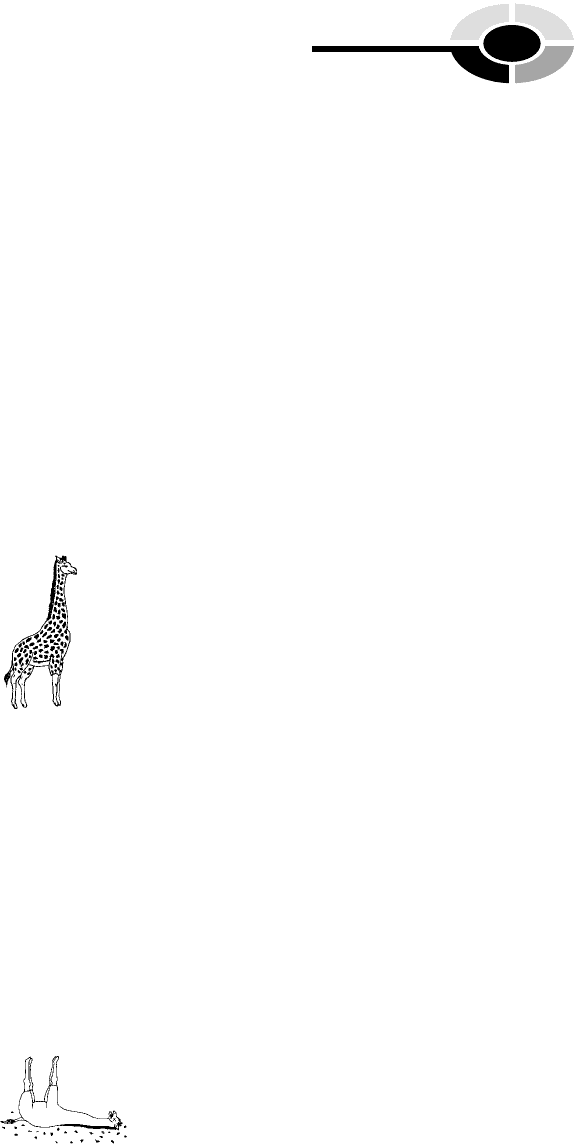
(b) Being so soft-bodied, have left behind virtually no traces within the
ancient Fossil Record
(c) May be alternately classified as bivalves
(d) Can be nicknamed as the ‘‘hedgehogs’’ of the Sea!
10. Which of the following would be a good example of ‘‘breaking
symmetry’’ of a sea urchin?
(a) Slicing the animal exactly in half along its body midline
(b) Pulling out every single one of the animal’s spines
(c) Extracting all of the spines on only the left side of the urchin’s body
(d) Pulling out every other spine, all over the surface of the urchin’s
body
The Giraffe ORDER TABLE for Chapter 10
(Key Text Facts About Biological Order Within An Organism)
1. ____________________________________________________________
2. ____________________________________________________________
3. ____________________________________________________________
4. ____________________________________________________________
5. ____________________________________________________________
The Dead Giraffe DISORDER TABLE for Chapter 10
(Key Text Facts About Biological Disorder Within An Organism)
1. ____________________________________________________________
CHAPTER 10 Invertebrates 175
[13:25 13/6/03 N:/4058 LAYMAN.751/4058-Alltext.3d] Ref: 4058 Layman: Biology Demystified All-text Page: 175 1-388
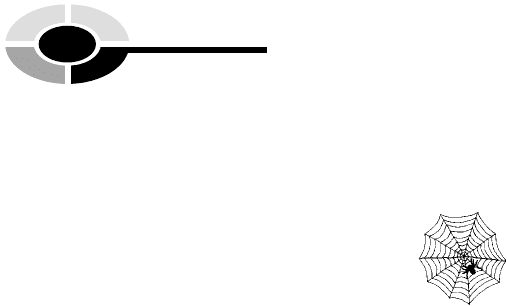
The Spider Web ORDER TABLE for Chapter 10
(Key Text Facts About Biological Order Beyond The Individual
Organism)
1. ____________________________________________________________
2. ____________________________________________________________
3. ____________________________________________________________
4. ____________________________________________________________
5. ____________________________________________________________
[13:25 13/6/03 N:/4058 LAYMAN.751/4058-Alltext.3d] Ref: 4058 Layman: Biology Demystified All-text Page: 176 1-388
PART 3 Five Kingdoms of Life, plus Viruses
176
